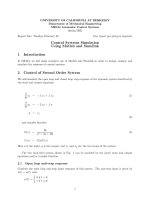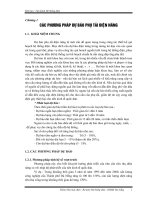Tài liệu Electronics Circuit Analysys Using Matlab P1 doc
Bạn đang xem bản rút gọn của tài liệu. Xem và tải ngay bản đầy đủ của tài liệu tại đây (206.4 KB, 23 trang )
Attia, John Okyere. “Matlab Fundamentals.”
Electronics and Circuit Analysis using MATLAB.
Ed. John Okyere Attia
Boca Raton: CRC Press LLC, 1999
© 1999 by CRC PRESS LLC
CHAPTER ONE
MATLAB FUNDAMENTALS
MATLAB is a numeric computation software for engineering and scientific
calculations. The name MATLAB stands for MATRIX LABORATORY.
MATLAB is primarily a tool for matrix computations. It was developed by
John Little and Cleve Moler of MathWorks, Inc. MATLAB was originally
written to provide easy access to the matrix computation software packages
LINPACK and EISPACK.
MATLAB is a high-level language whose basic data type is a matrix that does
not require dimensioning. There is no compilation and linking as is done in
high-level languages, such as C or FORTRAN. Computer solutions in
MATLAB seem to be much quicker than those of a high-level language such
as C or FORTRAN. All computations are performed in complex-valued dou-
ble precision arithmetic to guarantee high accuracy.
MATLAB has a rich set of plotting capabilities. The graphics are integrated in
MATLAB. Since MATLAB is also a programming environment, a user can
extend the functional capabilities of MATLAB by writing new modules.
MATLAB has a large collection of toolboxes in a variety of domains. Some
examples of MATLAB toolboxes are control system, signal processing, neural
network, image processing, and system identification. The toolboxes consist
of functions that can be used to perform computations in a specific domain.
1.1 MATLAB BASIC OPERATIONS
When MATLAB is invoked, the command window will display the prompt >>.
MATLAB is then ready for entering data or executing commands. To quit
MATLAB, type the command
exit or quit
MATLAB has on-line help. To see the list of MATLAB’s help facility, type
help
The help command followed by a function name is used to obtain informa-
tion on a specific MATLAB function. For example, to obtain information on
the use of fast Fourier transform function, fft, one can type the command
© 1999 CRC Press LLC
© 1999 CRC Press LLC
help fft
The basic data object in MATLAB is a rectangular numerical matrix with real
or complex elements. Scalars are thought of as a 1-by-1 matrix. Vectors are
considered as matrices with a row or column. MATLAB has no dimension
statement or type declarations. Storage of data and variables is allocated
automatically once the data and variables are used.
MATLAB statements are normally of the form:
variable = expression
Expressions typed by the user are interpreted and immediately evaluated by the
MATLAB system. If a MATLAB statement ends with a semicolon, MATLAB
evaluates the statement but suppresses the display of the results. MATLAB
is also capable of executing a number of commands that are stored in a file.
This will be discussed in Section 1.6. A matrix
A =
123
234
345
may be entered as follows:
A = [1 2 3; 2 3 4; 3 4 5];
Note that the matrix entries must be surrounded by brackets [ ] with row
elements separated by blanks or by commas. The end of each row, with the
exception of the last row, is indicated by a semicolon. A matrix A can also be
entered across three input lines as
A = [ 1 2 3
2 3 4
3 4 5];
In this case, the carriage returns replace the semicolons. A row vector B with
four elements
B = [ 6 9 12 15 18 ]
can be entered in MATLAB as
© 1999 CRC Press LLC
© 1999 CRC Press LLC
B = [6 9 12 15 18];
or
B = [6 , 9,12,15,18]
For readability, it is better to use spaces rather than commas between the ele-
ments. The row vector B can be turned into a column vector by transposition,
which is obtained by typing
C = B’
The above results in
C =
6
9
12
15
18
Other ways of entering the column vector C are
C = [6
9
12
15
18]
or
C = [6; 9; 12; 15; 18]
MATLAB is case sensitive in naming variables, commands and functions.
Thus b and B are not the same variable. If you do not want MATLAB to be
case sensitive, you can use the command
casesen off
To obtain the size of a specific variable, type size ( ). For example, to find the
size of matrix A, you can execute the following command:
size(A)
© 1999 CRC Press LLC
© 1999 CRC Press LLC
The result will be a row vector with two entries. The first is the number of
rows in A, the second the number of columns in A.
To find the list of variables that have been used in a MATLAB session, type
the command
whos
There will be a display of variable names and dimensions. Table 1.1 shows
the display of the variables that have been used so far in this book:
Table 1.1
Display of an output of whos command
Name
Size Elements Byte Density Complex
A 3 by 3 9 72 Full No
B 1 by 5 5 40 Full No
C 5 by 1 5 40 Full No
ans 1 by 2 2 16 Full No
The grand total is 21 elements using 168 bytes.
Table 1.2 shows additional MATLAB commands to get one started on
MATLAB. Detailed descriptions and usages of the commands can be obtained
from the MATLAB help facility or from MATLAB manuals.
Table 1.2
Some Basic MATLAB Commands
Command Description
%
Comments. Everything appearing after % com-
mand is not executed.
demo
Access on-line demo programs
length
Length of a matrix
clear
Clears the variables or functions from workspace
clc
Clears the command window during a work session
clg
Clears graphic window
diary
Saves a session in a disk, possibly for printing at a
later date
© 1999 CRC Press LLC
© 1999 CRC Press LLC
1.2 MATRIX OPERATIONS
The basic matrix operations are addition(+), subtraction(-), multiplication (*),
and conjugate transpose(‘) of matrices. In addition to the above basic opera-
tions, MATLAB has two forms of matrix division: the left inverse operator \
or the right inverse operator /.
Matrices of the same dimension may be subtracted or added. Thus if E and F
are entered in MATLAB as
E = [7 2 3; 4 3 6; 8 1 5];
F = [1 4 2; 6 7 5; 1 9 1];
and
G = E - F
H = E + F
then, matrices G and H will appear on the screen as
G =
6 -2 1
-2 -4 1
7 -8 4
H =
8 6 5
10 10 11
9 10 6
A scalar (1-by-1 matrix) may be added to or subtracted from a matrix. In this
particular case, the scalar is added to or subtracted from all the elements of an-
other matrix. For example,
J = H + 1
gives
J =
9 7 6
11 11 12
10 11 7
Matrix multiplication is defined provided the inner dimensions of the two op-
erands are the same. Thus, if X is an n-by-m matrix and Y is i-by-j matrix,
© 1999 CRC Press LLC
© 1999 CRC Press LLC
X*Y is defined provided m is equal to i. Since E and F are 3-by-3 matrices,
the product
Q = E*F
results as
Q =
22 69 27
28 91 29
19 84 26
Any matrix can be multiplied by a scalar. For example,
2*Q
gives
ans =
44 138 54
56 182 58
38 168 52
Note that if a variable name and the “=” sign are omitted, a variable name ans
is automatically created.
Matrix division can either be the left division operator \ or the right division
operator /. The right division a/b, for instance, is algebraically equivalent to
a
b
while the left division a\b is algebraically equivalent to
b
a
.
If
ZI V*
=
and Z is non-singular, the left division, Z\V is equivalent to
MATLAB expression
IinvZV
=
()*
where inv is the MATLAB function for obtaining the inverse of a matrix. The
right division denoted by V/Z is equivalent to the MATLAB expression
IVinvZ
=
*()
There are MATLAB functions that can be used to produce special matrices.
Examples are given in Table 1.3.
© 1999 CRC Press LLC
© 1999 CRC Press LLC
Table 1.3
Some Utility Matrices
Function Description
ones(n,m)
Produces n-by-m matrix with all the elements being
unity
eye(n)
gives n-by-n identity matrix
zeros(n,m)
Produces n-by-m matrix of zeros
diag(A)
Produce a vector consisting of diagonal of a square
matrix A
1.3 ARRAY OPERATIONS
Array operations refer to element-by-element arithmetic operations. Preceding
the linear algebraic matrix operations, * / \ ‘ , by a period (.) indicates an array
or element-by-element operation. Thus, the operators .* , .\ , ./, .^ , represent
element-by-element multiplication, left division, right division, and raising to
the power, respectively. For addition and subtraction, the array and matrix op-
erations are the same. Thus, + and .+ can be regarded as an array or matrix
addition.
If A1 and B1 are matrices of the same dimensions, then A1.*B1 denotes an ar-
ray whose elements are products of the corresponding elements of A1 and B1.
Thus, if
A1 = [2 7 6
8 9 10];
B1 = [6 4 3
2 3 4];
then
C1 = A1.*B1
results in
C1 =
12 28 18
16 27 40
© 1999 CRC Press LLC
© 1999 CRC Press LLC
An array operation for left and right division also involves element-by-element
operation. The expressions A1./B1 and A1.\B1 give the quotient of element-
by-element division of matrices A1 and B1. The statement
D1 = A1./B1
gives the result
D1 =
0.3333 1.7500 2.0000
4.0000 3.0000 2.5000
and the statement
E1 = A1.\B1
gives
E1 =
3.0000 0.5714 0.5000
0.2500 0.3333 0.4000
The array operation of raising to the power is denoted by .^. The general
statement will be of the form:
q = r1.^s1
If r1 and s1 are matrices of the same dimensions, then the result q is also a ma-
trix of the same dimensions. For example, if
r1 = [ 7 3 5];
s1 = [ 2 4 3];
then
q1 = r1.^s1
gives the result
q1 =
49 81 125
© 1999 CRC Press LLC
© 1999 CRC Press LLC









